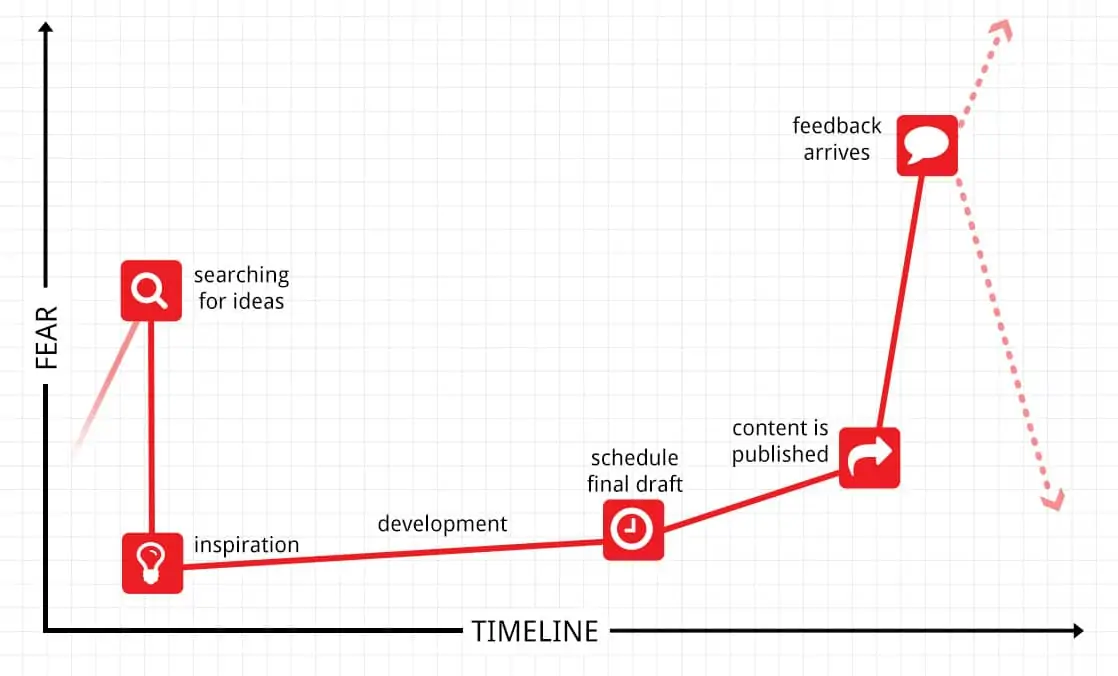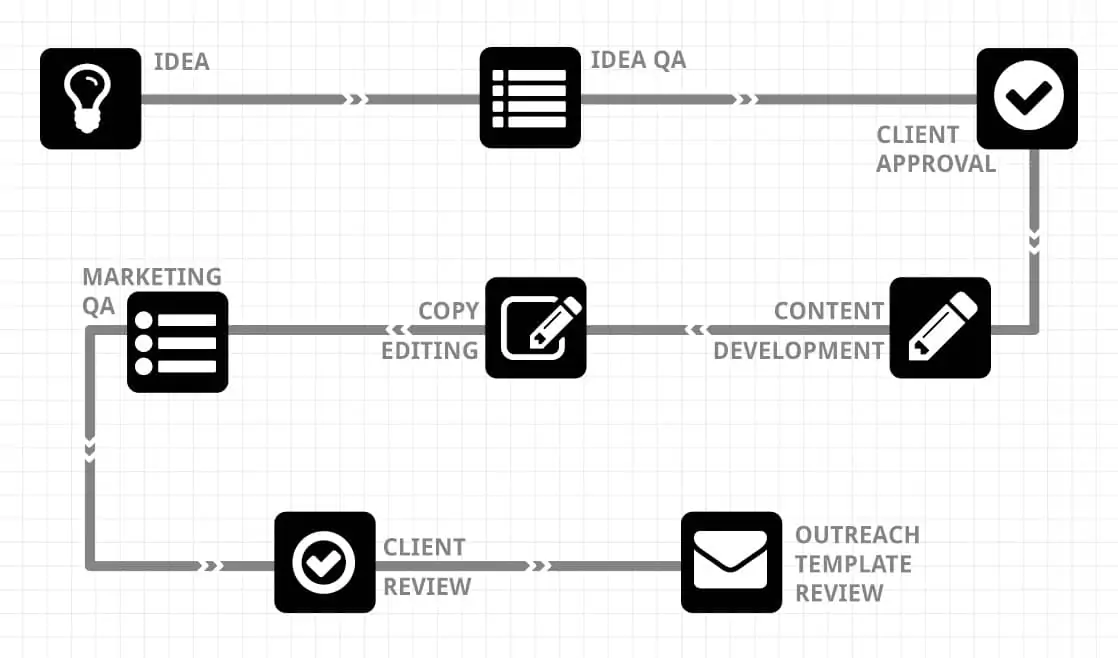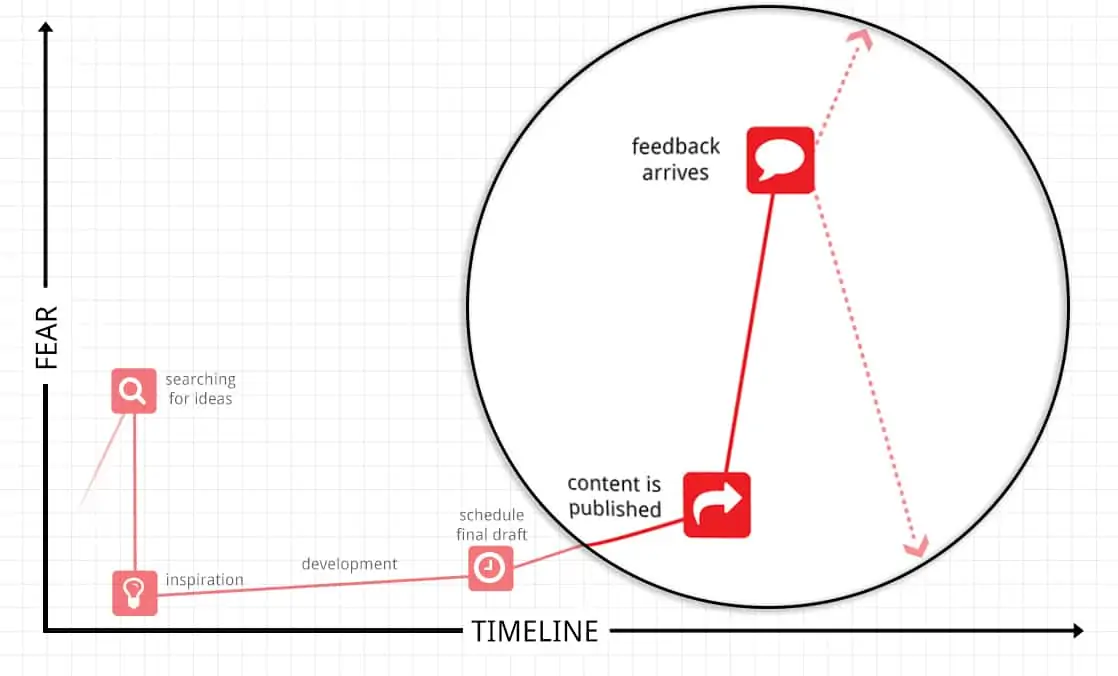I’ll admit it – I often have content launch anxiety. And as you might have heard, the best way to deal with a problem is admit that you have one.
Content launch anxiety, as I define it, is the fear and stress felt before a piece of content you’ve put a lot of blood, sweat and tears into is about to be launched. It’s the fear that you’ll hit publish and nobody will care, that people will boo and destroy you in the comments, and you’ll get zero shares and the entire internet will unfollow you in the next few minutes.
This, unfortunately, is a somewhat real fear that I – and I imagine many of you – have at the time of launching content. Your path of fear likely looks something like this:
Fear starts at the stage where you worry about what will happen if you don’t come up with an idea and never publish. This builds as time passes and still no idea has been thought of.
Fear then drops immediately as an idea is found and we move into the development stage, where thoughts begin to arise about whether or not the quality of our work is good enough and if it’ll be received well.
As we schedule the post and wait for feedback anxiety builds, at which point it takes off once we hit publish. Publishing accelerates the fear as we wait for feedback or the lack thereof – at which point it either crashes when we start receiving good feedback, or it accelerates as we learn that what we built just isn’t as good as we hoped.
A History of Fear
At noon the day of launch our advanced guide to StumbleUpon had 10 shares – and I seriously considered unpublishing it. It now has 300+ shares and was featured in the Moz Top 10.
I actually decided not to publish our post about Copyblogger’s Google Plus growth strategy and instead wrote a Google Plus post about it – only to flip flop and end up posting what I had drafted based on its success. It now also has 300+ shares between it and the original Google Plus post I wrote about it.
The anxiety is real, and it hits with every post. These are the feelings I had before launching each of the last five posts I wrote:
- How Copyblogger Increased Their Google Plus Growth Rate By 157% – Everyone would think this is a stupid post because we ended up deciding we shouldn’t disable comments and push people to Google ourselves.
- The Advanced Guide to StumbleUpon Marketing – Everyone already knew how to get traffic on StumbleUpon and/or our strategy was really stupid and other people were probably doing it way better without spending money.
- The Powerful Twitter Tactic 73.6% Of You Aren’t Using – The headline is really stupid and clickbaity and we’ll lose everyone’s respect. People will rip apart our research because it’s not statistically significant.
- 10 Content Creators to Inspire Your Content Marketing – You’re using a list post to market to marketers? Really?
- How to Reverse Engineer Success on Reddit – Reddit is going to ban your IP, read your soul and notice that time you submitted two client posts. Don’t do it.
And this is just our content. This isn’t our clients’ content, the content that matters. You can only imagine what kind of fear moves around my head in relation to that.
Dealing with Content Launch Anxiety
And although it’s obvious I do have a problem, that doesn’t mean I don’t have an action plan to prevent the pain from being as bad as it might be otherwise. And also, I do believe that content launch anxiety is a good thing – it means you care a ton about your work, and that you’re passionate about its success and making it the absolute best it can be. It’s a healthy anxiety – or at least, that’s what I’ll keep telling myself.
That said, you’ll probably never solve it completely – like having to keep an eye on our weight, it’s something we should continue to monitor to make sure it’s not getting the best of us, as it’ll never completely be washed away. Anxiety over our work is something that will surface forever (as long as we care about it), but it should also be something we fight against actively.
To prevent the fear from overtaking you, I suggest the following tips. Not only will they help your anxiety, but they should also help your content.
1. Have Editors For Your Editors
One of the biggest reasons for fear is “I’m afraid this sucks”. The best way to qwell that fear is make sure your content doesn’t suck, which can be solved for by having editors for your editors. Have someone edit your post, but also edit your editor, and edit your editor’s editor. I’m kidding, but I’m not. At Siege, this is what our content workflow looks like:
As you can see, the many levels of quality assurance and editing help pad the fact that our content is up to the standards we want it to be. When our content doesn’t work, we often look back at this review channel and realize a piece of it was missed, resulting in a less-than-effective piece of content.
By moving your content through a editing channel like this, you make sure no piece is lost. Your anxiety will be reassured by positive feedback and/or constructive criticism – making sure that by the time you get to final, you’re feeling pretty good about the end result.
2. Maintain a Checklist to Edit Your Editor’s Editor
Although humans are generally great editors, they’re also human. Sometimes, we forget things we should check for, a piece of our best-practice-brains is left at home with last night’s happy hour. This can happen more frequently than we’d like, and can often cause a critical miss in a piece of content that hurts the end product.
To help solve for this problem, we built an interactive marketing checklist that’s publicly available to you online. This checklist helps identify the cracks in your content’s exterior, and by either using it or taking its core and adding your own points, you can catch the problems human editors might have forgotten on a given day. Today, there isn’t a piece of content as part of our content marketing services package that does not go through this checklist.
Any time you can catch one of those problems you might have missed otherwise, there’s a calming response psychologically about the improvement you made to a piece of content that you already (hopefully) thought was pretty solid.
3. Jump to First Feedback
One of the worst periods of fear in the content launch cycle is right after you hit publish. Depending on the content and industry, you might not get first feedback on the piece for a day or two if it requires that you cold pitch journalists or don’t have an established audience.
This time before any feedback really drains you psychologically, because every second that passes creates the belief that the feedback you haven’t received is feedback in itself – that is, the people hated the content and didn’t feel like responding.
To solve for this silence, you can qualm the anxiety by finding any possible way to get immediate feedback on the content you’ve built. For sites with a large audience, it’s as easy as hitting publish and quickly sharing the content with all of your social channels.
For sites in the middle (like ours), we solve for it in a few ways: publishing at midnight (so we can start seeing feedback during a time where we can’t build anxiety), sharing the content with social channels immediately in the morning, and scheduling a release to our e-mail newsletter for earlier in the day. Sometimes it’s possible for a tweet to have very little reaction but the post to still have great success in this middle audience range – so these small shortcuts can help solve for the issue.
For sites without an audience at all, it can be a little tougher, but there are still shortcuts. Depending on the content, we’ll immediately seed to StumbleUpon, do paid promotion on Facebook, or (very sparingly) submit to Reddit. These channels give you immediate feedback in the form of likes, upvotes or otherwise, which can be a calming force for those with jittery nerves.
4. Aim for Doubles Without Losing Home Run Touch
I’m not against big content – I very much believe in it and know it can generate exponential returns. However, if you’re consistently swinging for doubles, it’s okay to occasionally strike out – as long as you have a strong on-base percentage. But if your business is swinging for home runs, variance could give you two strike outs and a lot of lost revenue – something most don’t want to experience.
By investing in “medium-sized” content, you put yourself on the path towards consistent success. Also, the added benefit is the anxiety cycle is a lot smaller and less intense – with big content, you simply can’t mess up, and the fear is a lot bigger. With medium-sized content, you ship, keep shipping and don’t really have time to feel bad about a failed piece – because you’ll quickly have a deadline for the next one you have to reach.
My suggestion to balance the perils of big content with its benefits is to diversify – if you’re going to do big content, intersplice it with medium-effort content so the fear doesn’t resurface with consistency. One key to lowering the impact of launch anxiety is having consistent success – therefore building your confidence – which can be more difficult to do if you’re constantly swinging for home runs (unless you’re Barry Bonds).
5. Solve for the Most Common Content Failure Point
Despite all of the above, one of the number one reasons content fails despite having every editing trigger met is a lack of exposure to the target audience before release. If you aren’t a member of the target audience, it’s hard to really know that your content connects with them or otherwise, if they aren’t very aware of something extremely similar to what you’re building/have built.
This is a fault most often of the Unexpected variable of the Made to Stick model I suggest you adhere to – because it’s hard for people outside the market to know what people inside the market know or don’t.
If your editors aren’t the target audience and your editor’s editors aren’t either, this failure can surface and be a big stopping point for many pieces of content. You can quell anxiety by getting someone in the target audience on the payroll, even for a quick glance/lookover of your idea and concept. A quick $20-$50 for editing and review of a piece of content is well worth it if it means the difference between success and failure.
Nothing will feel better than a “this is amazing!” kind of response from your target market pre-launch, and it’ll be the absolutely best sign you’re moving in the right direction.
The Key: Fail Fast and Succeed Often
Anxiety when launching content will never go away, but the best way to overcome its perils, in my opinion, is to fail fast and succeed often. With repeated success and a method of quick turnaround to the next project, it’s likely a lot less of the anxiety will show its face in your workflow.
Instead of the first, much taller graph I showed on this post, a good process can reduce your anxiety to a graph like this:
While that’s still not a fun timeline to be a part of, I’ll take it over the timeline we listed on the top of this post. There should be no vertical ascents of anxiety in your content development process.











